A vinyl fence is a great low maintenance option for enclosing your yard. Vinyl doesn’t rot, warp, or splinter like wood and it doesn’t require painting like a wood fence does. However, while vinyl is low maintenance, it does still require some regular care and cleaning to keep it looking its best. Keeping your vinyl fence clean helps maintain its appearance and can extend its lifespan.
Over time, vinyl fences can accumulate dirt, mildew, chalky buildup, and stains. Leaving these on the surface can make the fence look dingy and dated. Regular cleaning keeps vinyl fences looking like new. It’s also important for preventing stubborn stains from building up over time. A quick cleaning session every few months is all it takes to keep your vinyl fence sparkling.
In this guide, we’ll walk through the steps for keeping your vinyl fence clean. We’ll cover what supplies you need, how to clean it routinely, and tips for spot cleaning stubborn stains. With just a bit of regular care, you can keep your vinyl fence looking fresh and well-maintained for years to come. Read on to learn how!
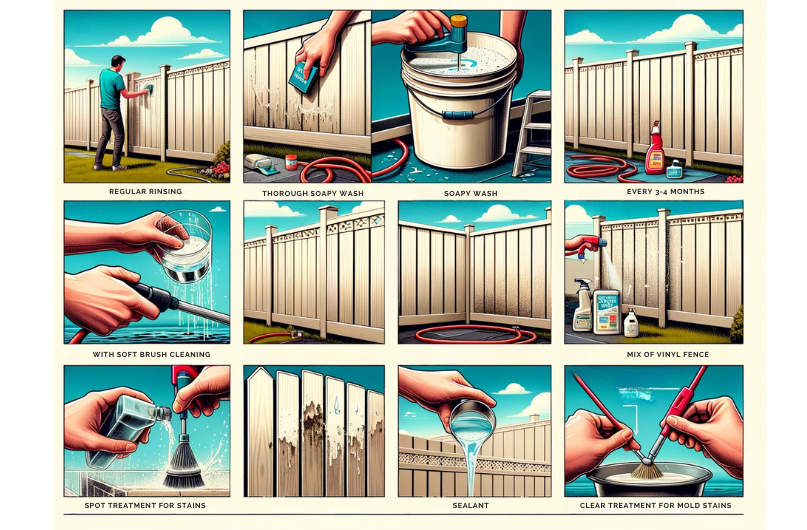
Routine Cleaning
Regular cleaning is essential for keeping your vinyl fence looking its best. How often you need to clean your fence depends on several factors:
- Location – Fences located near trees, dirt roads, or other sources of dirt and debris will need more frequent cleaning than fences in cleaner environments. Expect to clean fences in rural or wooded areas every 2-3 months.
- Weather – Vinyl fences are subject to weathering from sun, rain, snow, and wind. Frequent rain can lead to buildup of dirt, mildew, and algae. Plan to clean after winter weather and summer storms.
- Color – Light vinyl colors like white and cream show dirt faster than darker vinyls. Light colors may need cleaning every 2-3 months, while darker fences can go 4-6 months between cleanings.
- Usage – High-traffic yards with kids and pets will get dirtier faster. Clean when you notice pronounced dirt buildup.
For most vinyl fences, a thorough cleaning every 3-4 months is sufficient. Cleaning more frequently than every 2 months is usually overkill. Schedule cleanings before dirt gets heavily baked on by sun and rain. Monitor your fence and adjust cleaning frequency based on how quickly it accumulates grime.
Supplies Needed
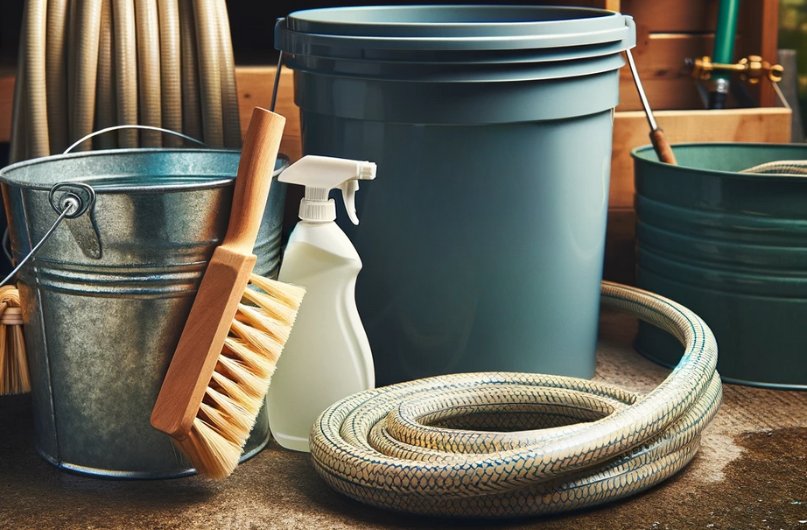
To properly clean your vinyl fence, you will need the following supplies:
- Bucket – Use a bucket to mix your cleaning solution. Choose one large enough to hold a few gallons of water.
- Hose – An exterior hose will provide running water to rinse your fence when you’re done cleaning. Make sure it can reach all areas of your fence.
- Soft brush – Use a soft bristled brush to scrub your fence without scratching it. Look for a brush with natural bristles. Avoid stiff plastic brushes.
- Mild soap – Mix a few tablespoons of mild dish or laundry soap into your bucket to make the cleaning solution. Avoid harsh detergents.
Be sure to have all of these supplies ready before starting to clean your vinyl fence. This will make the process quicker and easier. With the right tools, you’ll be able to thoroughly clean your fence.
Pre-Rinse
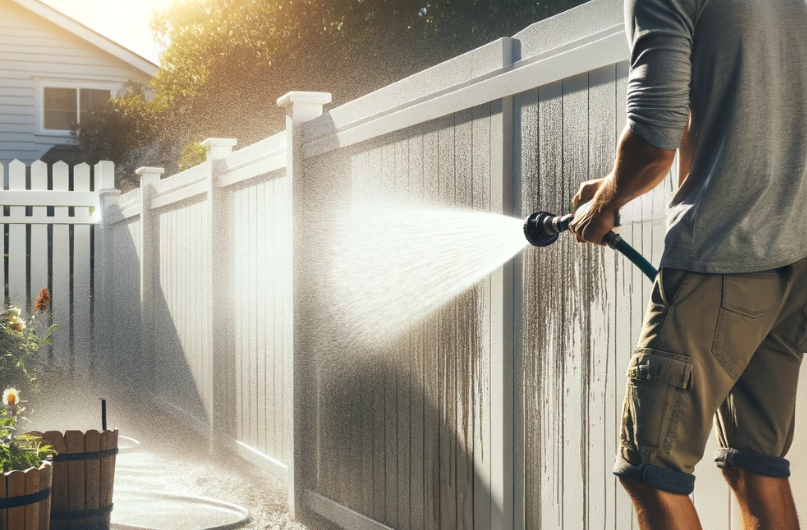
After removing any loose debris with a broom or leaf blower, take a garden hose and spray down the entire vinyl fence. The pre-rinse will help loosen and wash away any remaining dirt, pollen, mold or mildew that has accumulated on the surface. Adjust the nozzle to a strong but focused stream of water rather than a wide dispersal spray. Work methodically section by section starting at the top and covering every plank moving down until you reach the bottom. Pay extra attention to splashing water into crevices and undersides of fence boards that often collect more grime. The pre-rinse allows you to see the true condition of the vinyl material once the initial layer of debris is removed. It also prevents that loose dirt from scratching the fence when scrubbing if it were still present. A thorough pre-rinse makes the rest of the cleaning much easier and more effective.
Mix Soap Solution
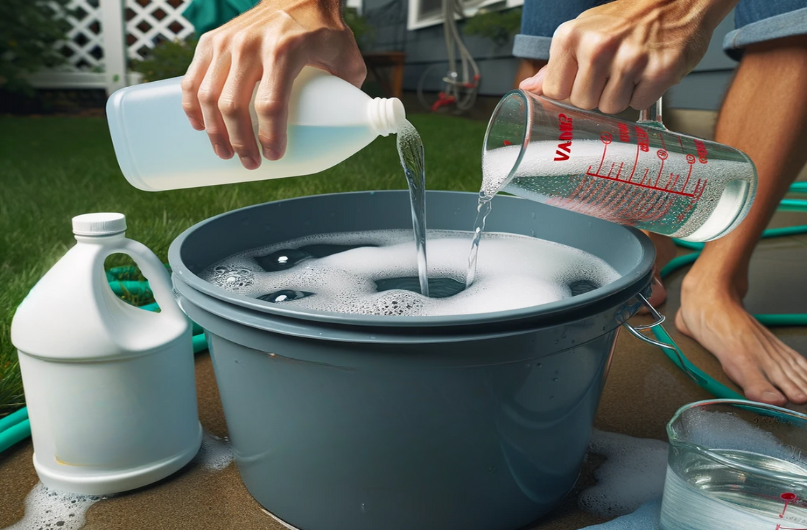
Mixing a simple soap solution for cleaning vinyl fences helps lift and remove dirt without damaging the fence surface. It’s important to use a very mild detergent, as harsh soaps or cleaners could potentially fade the color or strip off protective coatings over time.
The ideal cleaning solution is:
- 1-2 gallons of lukewarm water
- 2-3 tablespoons of mild liquid dish soap or laundry detergent
- 1/4 cup white vinegar (optional for extra cleaning power)
Only mix as much solution as needed for each cleaning session. It’s best to start with the lowest amount of detergent and increase if needed.
Fill a bucket with the lukewarm water, then stir in the detergent until dissolved. For a bit of extra cleaning power, you can also add the vinegar. The solution should be sudsy but not thick. Test on a small area first before applying widely.
Be sure to use a high-quality detergent marketed as gentle, mild, or soft on surfaces. Avoid powders, bleaches, oils, or anything too concentrated. The goal is a very diluted, low-sudsing solution that lifts dirt without risking damage to the vinyl over repeated use.
Scrubbing
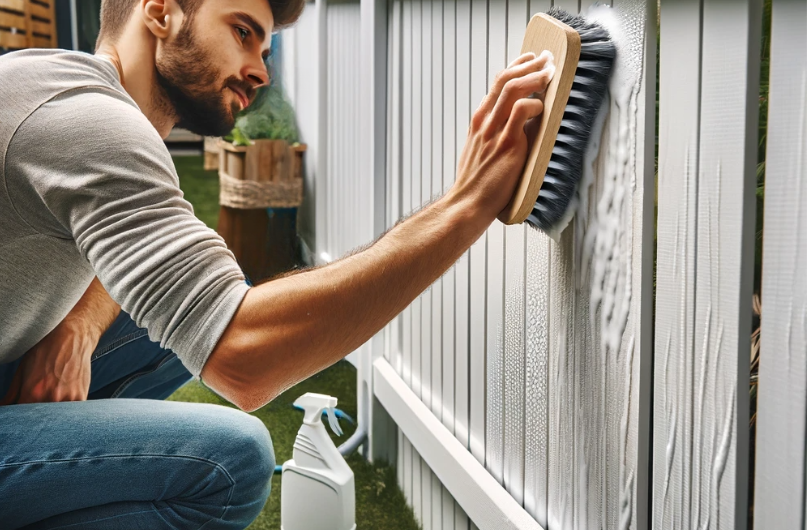
Use a soft-bristled brush to gently scrub all surfaces of the vinyl fencing with the diluted soap solution. Apply light pressure as you scrub to avoid scratching the vinyl. Focus on areas with noticeable dirt, grime, or stains, spending more time scrubbing these spots to break up the residue.
Scrub up and down the length of each fence board, rail, and post to remove debris. Pay close attention to scrubbing crevices, corners, and any engraved design details in the fencing.
Make sure to scrub both sides of every fence component. If the fence has decorative tops or fence caps, carefully scrub these as well.
Rinse frequently as you scrub to prevent dirt and grime from re-depositing on the fencing. Change your scrub water often to keep it clean.
Thorough scrubbing with a soft brush and diluted soap solution will help restore the vibrant look of your vinyl fencing without risk of damage.
Rinsing
After scrubbing your vinyl fence with the soap solution and a soft brush, it’s important to thoroughly rinse off any remaining soap residue. Use a garden hose with a pressure nozzle or a power washer on a low pressure setting. Start at the top and work your way down methodically, rinsing off each section as you go.
Focus the water stream directly on the fencing to wash away the soap. If you used a soft brush, also aim the water stream underneath and on the edges to rinse away any soap that seeped into crevices. Rinse until the water runs clear and you no longer see traces of soap bubbles or residue on the fencing.
The key is to be thorough and patient during the rinsing process. Any leftover soap can attract dirt and promote mildew growth. Taking the time to properly rinse will help your vinyl fence retain its clean appearance longer after washing.
Spot Cleaning
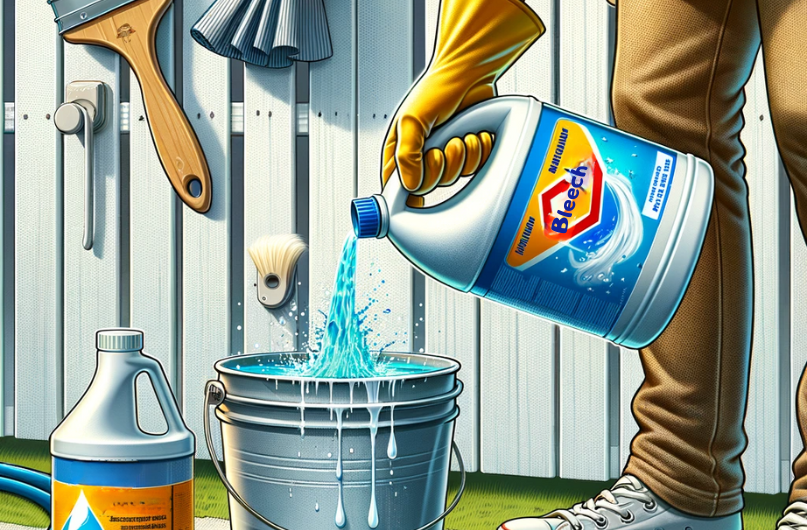
Vinyl fences are prone to accumulating mold, mildew, and other stubborn stains over time. It’s important to tackle these issues as soon as you notice them to prevent permanent damage or discoloration.
Start by mixing together a cleaning solution of 1 part bleach to 3 parts water. Make sure to use bleach that does not contain any additives or fragrances, as these can potentially damage the vinyl. Wear gloves and eye protection when working with bleach.
Use a soft bristle brush to gently apply the bleach solution directly to any mold, mildew, or stain. Allow it to sit for 5-10 minutes so the bleach can penetrate and lift the grime. Do not allow the bleach to dry on the surface.
After letting it sit, use a garden hose to rinse away the bleach thoroughly. You may need to scrub gently with the soft bristle brush to remove stubborn spots.
For extra stubborn stains that don’t budge, try making a paste with baking soda and water. Use a cloth to rub the paste onto the stained area, let sit for 15 minutes, then rinse. The abrasiveness of the baking soda can help scrub away difficult stains.
Be patient and persistent with spot cleaning. It may take multiple applications and scrubbing sessions to fully remove built-up mold, mildew, and stains from your vinyl fencing. But putting in the elbow grease regularly will keep your fence looking fresh and clean.
Sealing
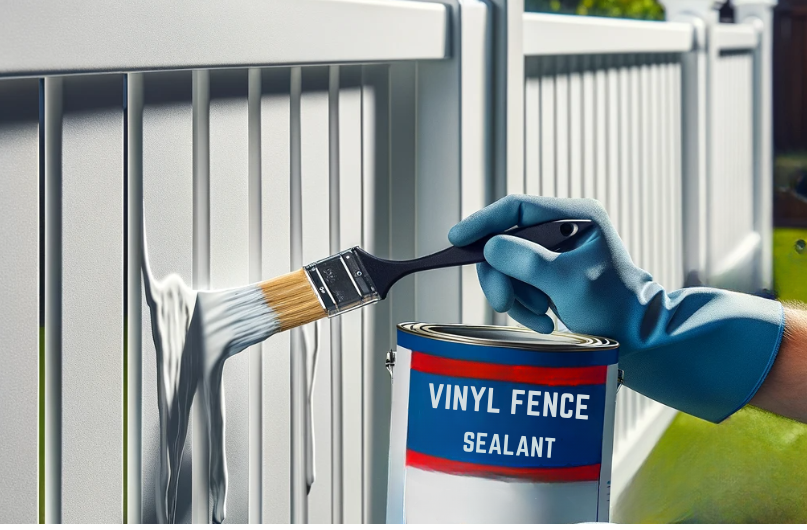
Applying a sealant is the best way to protect and maintain the appearance of your vinyl fence. Over time, exposure to the elements can cause vinyl to fade, chalk, or discolor. A sealant forms a protective barrier that prevents damage from moisture, UV rays, dirt, and pollutants.
When shopping for a sealant, look for a water-based, 100% acrylic formula made specifically for vinyl fences. Acrylic sealants offer superior adhesion, flexibility, and longevity compared to cheaper latex or oil-based options. They protect against fading while allowing the vinyl to expand and contract naturally.
Plan to seal your vinyl fence every 1-3 years. First, use a pressure washer to thoroughly clean the fence and allow it to dry completely. Then apply the sealant with a paintbrush or handheld sprayer, following the manufacturers directions for application and dry time. Apply evenly across all surfaces, paying special attention to horizontal rails where moisture can collect.
Sealing will restore your fence’s vibrant color and provide a like-new appearance. It also fills in small scratches and blemishes. Be sure to reapply after any cleaning or pressure washing to maintain the protective barrier. With regular sealing, your vinyl fence will look great for years.
Conclusion
Keeping your vinyl fence looking its best requires dedication to routine cleaning and maintenance. By regularly removing dirt, grime, mold, and mildew buildup, you can help prevent long-term staining and damage. Make cleaning a part of your regular exterior maintenance schedule.
A quick rinse-down every few weeks and a thorough scrubbing every 3-4 months is ideal. Pay special attention to problem areas prone to mildew growth. Keep your cleaning supplies on hand so you don’t put it off.
With proper care, your vinyl fence will maintain its vibrant color and withstand the elements for years to come. The small investment of time required for cleaning is well worth it for the aesthetic appeal a clean fence provides. Curb appeal starts with the fence. Keep it looking fresh and your entire property will benefit.
A routine cleaning regimen removes not just surface dirt but the chance for deterioration. Don’t wait for staining or mildew to take hold. Be proactive and keep your vinyl fence pristine. The effort leads to pride in your property.

0 Comments